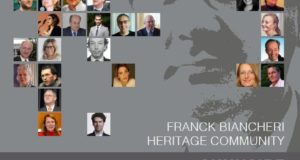Organisé en partenariat avec la Ville de La Haye
Concept
The need for closing the gap between the EU institutions and the European citizens, the changing nature of European societies moving towards a “network society”, the enlargement of the EU, the revolutions of communication (high speed trains, cheap flights) and telecommunication (Internet), all that is pleading for a radical restructuring of the historic axis of the European institutions (Brussels-Luxemburg-Strasburg).
A growing number of political players as well as economic and social operators tend to agree with this requirement for a new distribution of the European capitals
Currently the core idea is to mixed two different concepts :
1. the EuroRing 1 concept, based on a de facto emergence of the European Global Conurbation in the area comprising London, Paris, Delta Metropolis in the Netherlands (Utrecht-Amsterdam-The Hague-Rotterdam), Rhein Gebiet (Frankfurt, Köln, Bonn) and Brussels-Antwerpen. This area being the core of a network.
2. the European Capital Cities Network, which assumes that the historic capital of the EU Member-States are the “natural/historical” location for distributing the European political and administrative power.
The main challenge is first of all to identify the criteria and constraints which apply to the European Union political and administrative system ; and to match it with two other factors : the logistical, practical implementation of the new distribution ; and the political, popular expectations of the populations concerned when it comes to accommodate a specific EU institutions. In short, one cannot put anything anywhere ; and EuroRings aims at preventing future “horse trading” processes which are the basis of EU institutions localization since 1951.
Experts from cities, regions, companies, think-tanks and administrations will gather for one day to debate these issues around the following 4 topics :
1. The instrument : Merging the EuroRings concept and the European Capital Cities Network : towards a European Institutional network
2. Matching the efficiency constraints : Marrying EuroRings cities and EU institutions
3 Matching the political constraints : Marrying a country with an institution – towards a matrix of expected role and identity answers for the different European people
4. Main outlines for a possible map and calendar
Programme
9.00 – 9.30 : Opening Session
. Mr Franck Biancheri, Director of Studies and Strategy for Europe 2020
. Mr Thom De Bruijn, Director General for EU Affairs, MFA, The Hague
. Mr Arend Hilhorst, Deputy Mayor for Town Planning, City Renewal & Housing, The Hague
9.30 – 11.00 : Merging the concept of Eurorings with the Network of European Capital Cities – Towards a European Institutional network
Rationale : Eurorings is a concept based on two different dimensions :
1- a geographical and technological dimension (ability to connect efficiently key cities in different EU countries to insert them into a European network able to deliver trans-European political and administrative services)
2- a political dimension (the existence of National Capitals being historical recipients of political legitimacy in modern European history and their potential as being a natural ‘European Capitals Network).
The aim of this first session is to see how the two dimensions interact and can be integrated into a single EuroRings concept and model.
Interventions :
– The emerging of new European conurbations :
. “Deltametropolis”, a Presentation by Mr Dirk Frieling
. “Reinforcing the link between European regions : potentioalities of the Interred tool”, a contribution by Mrs Armelle Guyomarc’h, Head of EU affairs department, Région Ile de France
. “Toward an emerging Thalys-EuroStar new trans-European conurbation”, a Presentation by representatives of Thalys and EuroStar
– Internet/Information Technologies and the new abilities to integrate decentralized operational and decision making systems :
. “E-decision making in a decentralized system”, Presentation by Mr Régis Jamin, Vice-President EMEA, Election.com
. “IPV6 – the new Internet standard – and its implications for e-management of decentralized systems”, Presentation by Mr Jonathan Robin, Internet Society
. Debate
11.30 – 12.45 : Marrying a country with an institution – towards a matrix of expected role and identity among the different European people
Rationale : EuroRings requires at this stage visions of one to three possible scenarios for matching up institutions and cities. To elaborate such innovative ‘pictures’ of EU future political and administrative system (looking 10/15 years ahead), very precise and objective instruments, criteria are required including in the field of ‘national public opinion’ expectations. In past years, EU experience has shown that not all kind of institutions seem attractive to any European nation ; neither that any ‘European people’ looks fit for welcoming a particular EU institution, in the eyes of the other Europeans. Expected roles and identity concern of each European people do play a role in such a scenario build-up, requiring clarification.
Interventions :
.“An example of allocation of EU institutions : The Hague as City of Peace and Justice, an advantage for the European Union in global perspective”, Contribution by Mr Bas Verkerk of the City of The Hague (approx. 20 minutes)
. “Criteria and competency of Frankfurt as location of the ECB”, a contribution by Mr Dr Gunter Stemmler, Mayor’s Advisor, City of Frankfurt
. “Presentation of a possible European Role/Identity Matrix”, Europe 2020
. Debate
13.00 – 14.30 : Lunch
14.00 – 16.00 : Matching the efficiency constraints – Marrying EuroRings cities and EU institutions
Rationale : EuroRings is based on the understanding that the current EU political and administrative system is moving towards a network type of organization (decentralized geographically and much less hierarchical in terms of interaction between its different components, with a core group of institutions – ensuring the network leadership – requiring a broader band of information flow, and a large number of other institutions enabled to interact less closely in between themselves. A first attempt to identify the possible segmentations of the current EU administrative system is needed in order to understand how many components it may include. This step can be conducted with the analysis of how current decentralized institutions where allocated to a particular city and what were the successes and failures of the existing system.
Interventions :
. Introduction by Mr Gijs de Vries, Dutch delegation member of the Convention on the future of Europe (approx. 10 minutes)
. “Existing tensions that exist between Europeans vs. the efficiency of EU institutions”, Contribution by Mr Jan van Dijk, spokesman CDA in Dutch Parliament and deputy member of the European Convention
. Debate
16.00 – 18.00 : Main outlines for a possible map and calendar – General assessment of the debates – Definition of the following steps
. Conclusions by Mr Franck Biancheri, Director of Studies and Strategy for Europe 2020
. Debate
18.00 – Closing of the seminar
Participants
. Dick Benschop, Former Secretary General of Foreign Affairs in The Netherlands
. Philippe Bernhard, Head of Office, Bureau Alsace, Bruxelles
. Mark Beunderman, Ph D Student, Dutch correspondent, EU Observer
. Franck Biancheri, Director of Studies and Strategy, Europe 2020
. Marie-Hélène Caillol, Vice-President, Europe 2020
. Cecile Clappers, European Affairs, City of The Hague
. Alain Clerc, Civil Society Co-ordinator at the World Summit of Information society
. Thom De Bruijn, Director General, Department of European Integration, Ministry of Foreign Affairs
. Frans van Bork, City of The Hague
. Jan van Dijk, Spokesman political party CDA in Dutch Parliament
. Frank van Dijk, Personnel assistant Jan van Dijk
. Geert Dijkstra, Deputy Head International Desk, City of The Hague
. Harald Greib, German Civil German, Ministry of Interior / Vice President, Europe 2020
. Armelle Guyomarc’h, Department of European Affairs, Région Ile de France
. Arend Hilhorst, Alderman for Town Planning, City Renewal & Housing, City of The Hague
. Régis Jamin, Vice-President EMEA, Election.com
. Lisbeth Kirk, Chief Editor, EU Observer
. Fred Lafeber, Ministry of Economy, The Hague
. Bob Lagerwaard, Head International Desk, City of The Hague
. Gabri van der Let, Trainee City of The Hague
. Alexander Messelaar, City of The Hague
. Esther Palsgraaf, Deputy Director of the Amsterdam-Maastricht Summer University
. Jonathan Robin, Liaison Internet Society UNESCO-OCDE
. Ernst John Kaars Sijpesteijn, Manager, Voice of Civil Europe
. Gunter Stemmler, Advisor o the Mayor of the City of Frankfurt
. Christiaan Vaillant, Adviser on Spacial Planning, City of The Hague
. Bas Verkerk, Alderman Economy & Personnel, City of The Hague


 LEAP2040 Toutes les informations et archives Europe2040
LEAP2040 Toutes les informations et archives Europe2040
